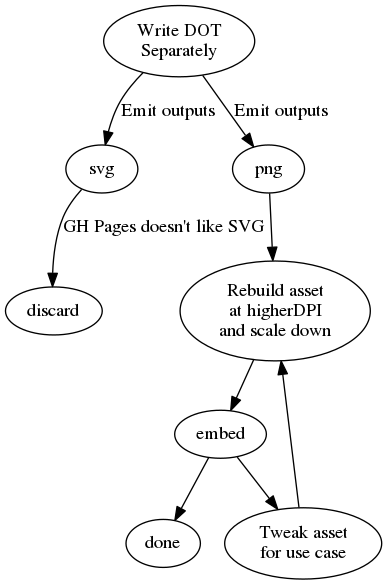Mike's Notes
Mike Mol's blog. Discussing why's, how's and random technical musings.
Graphviz content in Jekyll via Javascript
by Mike Mol
So, most of what I want to write about (if you dig around GitHub, you can find my backlog as a bunch of empty draft posts) involves Dot and GraphViz. But as nice as Jekyll and Markdown are for blog posts, the simplest workflow has me separately building Graphviz assets into PNG or SVG and embedding them, and then due to GitHub limitations, ditching the SVG version, generating the PNG version at a silly size and scaling it down:
digraph graphviz_workflow {
write_asset -> {svg png} [label="Emit outputs"]
svg -> discard [label="GH Pages doesn't like SVG"]
png -> rebuild -> embed -> {rewrite_asset done}
rewrite_asset -> rebuild
write_asset [label="Write DOT\nSeparately"]
rebuild [label="Rebuild asset\nat higherDPI\nand scale down"]
rewrite_asset [label="Tweak asset\nfor use case"]
}
…except here’s the real problem: You’re looking at a Dot representation of the workflow I just mentioned, not a visual representation. What I want is to be able to write Dot code in line with my posts, and have that content presented to you visually.
It looks like what I want is a Jekyll generator module that will let me convert inline Dot code like the above into something visual. These exist, but the ones I’ve found so far call out to an installation of Graphviz that’s on the server to do the render work.
If I’m using somebody else’s server (i.e. GitHub Pages, as I am at the moment), that’s not a solution I care for; it means hoping their Jekyll setup permits call-outs like that, hoping it has Graphviz installed, hoping it’s the right version…if I was running a server, especially a free service, I would discourage users from executing arbitrary code.
Instead, I think what I’d like is a generator module that embeds vis-js, a Javascript GraphViz implementation and has the render work performed on the client side. Falling back to a cruddy pre-rendered PNG if that’s not possible.
I think that workflow would work a lot better for me. So instead of the Dot code, you see above, you’d see a clean, SVG-defined inline-image. And if that didn’t get rendered, you’d at least see a static pre-rendered PNG that looks something like this:

So, you might not see quite what’s wrong with that. Admittedly, it does look better than if I were to render that content on my work laptop. Here, the font-kerning is horrible, but at least the font hinting works better. I’ve got a separate post (or a few) on that topic.
Though, text rendering belongs on the client. The client knows about the display, knows about pixel size, shape, subpixel orientation, etc.
So, real quick, let’s find out if client-side rendering is the proper solution to this.
Now, that renders fine using Jekyll and local preview on my laptop. But will it be when I upload this doc to GitHub? I’ve heard it doesn’t, but we’ll have to see!
tags: